2024 Summer Session Two Digital Photography [REMOTE]
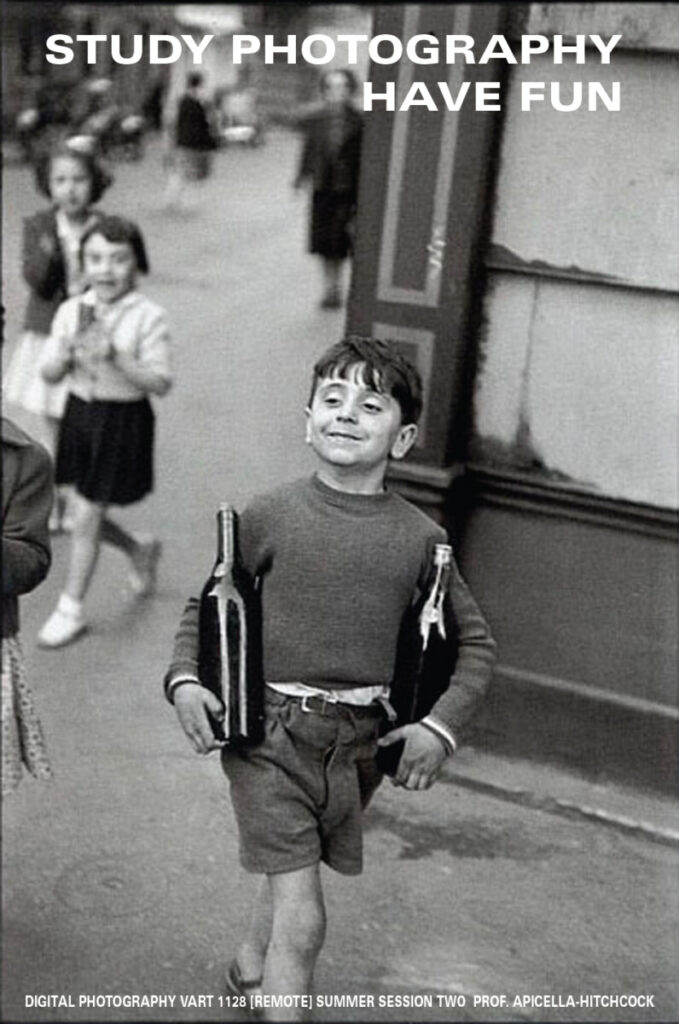
As the poster says, “Study Photography—have fun!” 2024 Summer Session 2 Digital Photography [remote]. Feel free to join our merry band of image makers.



As the poster says, “Study Photography—have fun!” 2024 Summer Session 2 Digital Photography [remote]. Feel free to join our merry band of image makers.


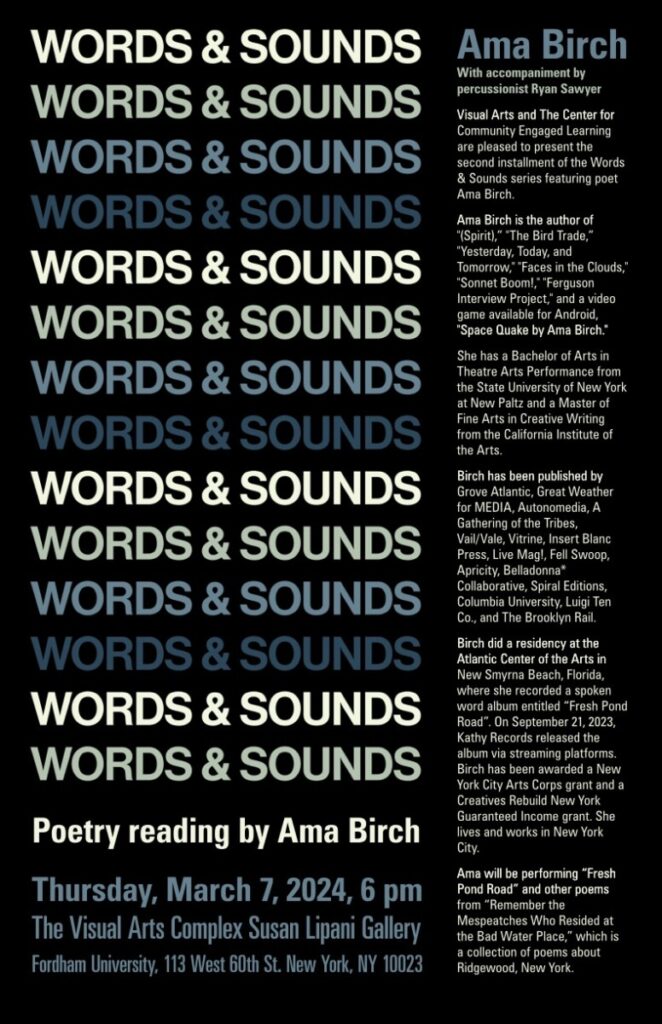
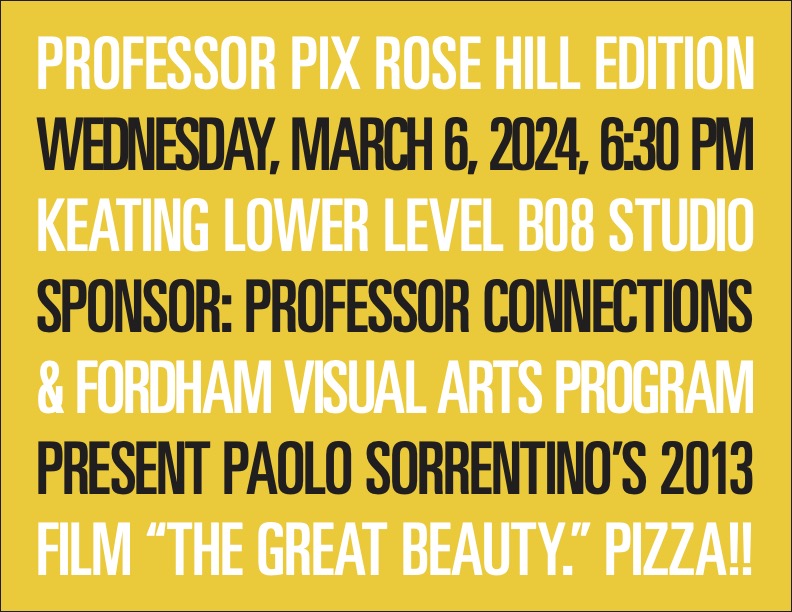
Dear Visual Arts Majors, Minors, Professors, Administrators, and Cinema Lovers,
Each season, we ask professors in the Visual Arts Program to present significant films to the Fordham community. At screenings, we enjoy pizza together, watch a movie, and then discuss it afterward. So, we invite you to step outside your regular streaming queue, experience something different, and join our community of merry cinephiles throughout the semester. The series is called Professor Pix, and it’s a visual and auditory blast—so join us—and bring your friends!
With La Dolce Vita (the Sweet Life), Italian filmmaker Federico Fellini vividly described the journeys of a protagonist through the vortex of 1960s socialites in Rome. With Paolo Sorrentino’s 2013 homage, The Great Beauty, the meanings and messages are updated for a new generation. On Wednesday, March 6th, at 6:30, the Professor Connections Program and the Visual Arts Program will co-sponsor the first Rose Hill Edition of Professor Pix! with Paolo Sorrentino’s The Great Beauty, selected by Professor Stephan Apicella-Hitchcock.
Sorrentino stated that one of the inspirations for his movie was the statement by the French novelist Gustave Flaubert that he wished to write a novel about nothing. “By ‘nothing,’ he meant the rumors and gossip, the thousand ways we have of wasting time, the things that irritate us or delight us but that are so short-lived that they make us doubt the meaning of life. That ‘nothing’ makes up many people’s entire lives.” Sorrentino also wanted to depict “the great thing about life, the fact that you can be surprised by something that you’d decided was vulgar and wretched, and then suddenly what is vulgar and wretched reveals its own entirely unexpected grace.”
How could a film supposedly about nothing be so captivating and full of grace, you ask? Come find out.
Wednesday, March 6th, at 6:30, Rose Hill Campus, Keating Lower Level Visual Arts Studio B08.
Pizza and camaraderie courtesy of the Professor Connections Program and Visual Arts.
Open to everyone.
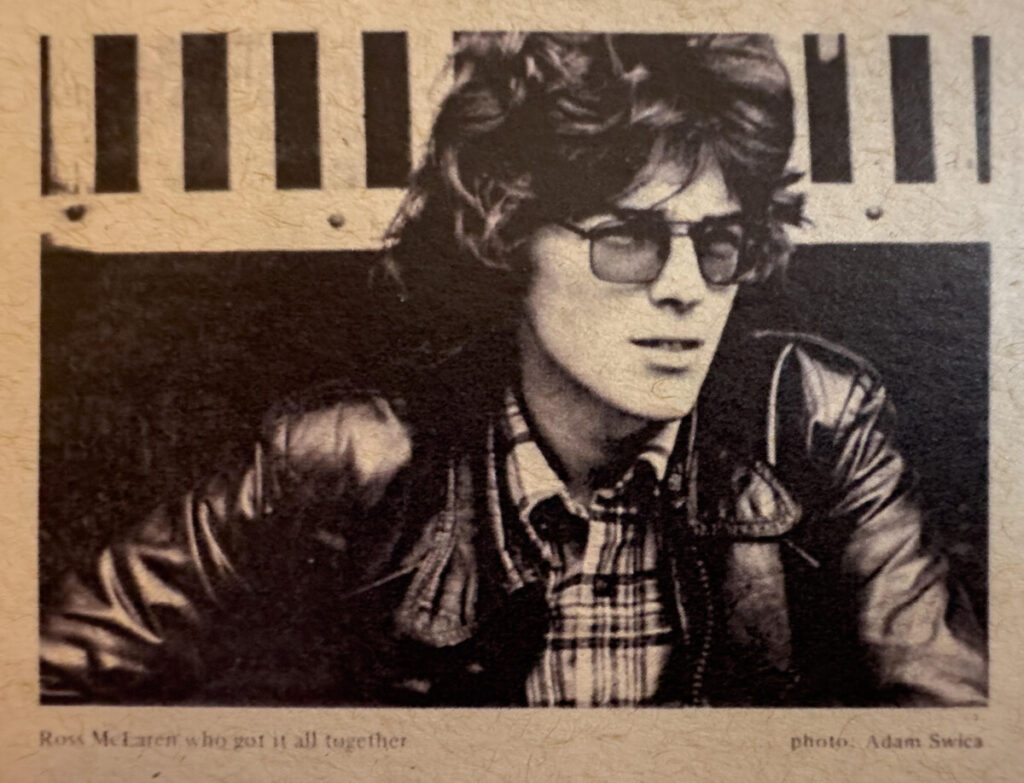
The Muse was Life; the Medium Was Film:
Films by our charming resident contrarian Ross McLaren and his students
Fordham University’s Susan Lipani Gallery
February 12 –February 29, 2024
Opening Reception: February 16, 6 pm
Fordham University at Lincoln Center map
113 West 60th Street at Columbus Avenue
New York, NY 10023
Map to the Lipani Gallery
fordhamuniversitygalleries
The Fordham University Visual Arts Program would like to announce this memorial exhibition, The Muse was Life; the Medium Was Film: Films by our charming resident contrarian Ross McLaren and his students in our Lincoln Center Visual Arts Complex Susan Lipani gallery.
Ross McLaren died in November of 2023, days short of his 70th birthday, after suffering a stroke earlier in the summer. Ross was a Canadian-born filmmaker, curator, colleague, teacher, and mentor living in New York who taught at Fordham University since 1986. This memorial exhibition highlights Ross’ dedication to the film medium and his influence on generations of Fordham University film & video students.
We miss his presence and take solace in the many memories he leaves behind. If Ross were here today, he would be holding court, telling stories, quick to share a toast, and likely one of the last to leave. There was only one Ross, unique as each of his films. In life, there is an endless continuation of frames; we thank Ross for sharing the ones he pulled from it.
Three monitors in the gallery space present Ross’ work. On monitor #1 is his infamous 1977 (27.75 min) film Crash ‘n’ Burn, shot on 16mm black & white film with an overdubbed soundtrack, documenting the Toronto, Ontario, Canada punk rock scene. On monitor #2 is Sex Without Glasses,1983, (12.75 min), a color, 16 mm film “starring a preverbal somnambulist floating between word and object.” –RM. And on monitor #3 is a selection of films that Ross admired from other filmmakers, including a range from Chris Marker’s La Jetée to cartoons about Porky the Pig.
Monitors #4 and #5 display nine short works (eight by Ross’ students over the years, one by a colleague): Spencer Balter, 5 am Thoughts at 3 in the Afternoon; Masha Bychkova, Gag; Alex Chambers, Cameraless Animations; Matt Gioia, Quick Sand; Liam Kenny, Joy, and Love for All Things in the Garden; Luke Momo, The Stamp Collector; Booch O’Connell, Affirmations; Glen Redpath (friend), Ross’s Rooftop Garden; Koty Vooys, Leaving NYC.
Fully circling the gallery and connecting Ross with his students are his used Super-8 film cartridges, a further reminder of Ross’ continued love of the film medium since the early days when he founded and was the first director of the Funnel Film Centre in Toronto, Ontario, Canada.
A memorial event in the Susan Lipani Gallery will occur on Friday, February 16, at 6 pm.
The Visual Arts Program would like to thank the Filmmakers’ Coop, who provided the 16mm print of Crash ‘n’ Burn and a digitized version of Sex Without Glasses, and special thanks to FCLC Dean Auricchio and FAS Dean Hume for funding the memorial event.
Stephan Apicella-Hitchcock and Joseph Lawton arranged this memorial with the assistance of Gallery Programmer Vincent Stracquadanio. Anibal Pella-Woo and Stephan Apicella-Hitchcock oversaw digitizing Crash ‘n’ Burn. Student films were collected and organized by Slav Velkov, Colin Cathcart, Eamon Redpath, and Glen Redpath, who assembled the list of Ross’ favorite movies, and Wilson Duggan installed the exhibition.
For more information, contact Stephan Apicella-Hitchcock
For the Visual Arts Department Blog: click here.
For the Visual Arts Department Website: click here.
Instagram: @visualartsfordham

Barbara Morgan, Martha Graham, Letter to the World, Swirl, 1940,
gelatin silver print, courtesy of the Fordham University Library Archives and Special Collections
From the Archives III:
Photographs by Barbara Morgan
Fordham University’s Ildiko Butler Gallery
January 29–February, 25, 2024
Opening Reception: February 8, 6 pm
Fordham University at Lincoln Center map
113 West 60th Street at Columbus Avenue
New York, NY 10023
Map to the Lipani Gallery
fordhamuniversitygalleries
Curators: Stephan Apicella-Hitchcock, Head of Visual Arts; Linda Loschiavo, Director of Libraries; and Gabriella DiMeglio, Archives and Special Collections Librarian
From the Archives: Photographs by Barbara Morgan brings together twelve black and white photographs from the Fordham University Archives and Special Collections housed at the Rose Hill Walsh Family Library. This exhibition is the third installment of the From the Archives series, which aims to highlight the rich and varied nature of Fordham University’s collections.
Barbara Morgan (1900–1992) represents a significant figure in the history of photography, particularly as the scope of her practice included very different photography styles. Half the works on display are samples from her studies of American modern dancers, and half represent her investigations in Russian Constructivist-inspired experimental photomontage.
In Barbara Morgan’s 1941 book, Martha Graham: Sixteen Dances in Photographs, Graham comments, “It is rare that even an inspired photographer possesses the demonic eye which can capture the instant of dance and transform it into timeless gesture… For to me, Barbara Morgan through her art reveals the inner landscape that is a dancer’s world.” The timing and precision required to record the essence of a dance taking place over time and transform it into a singular, iconic photograph is extraordinary and forms a counterpoint to Morgan’s photomontage experiments, which consciously bring together different images into dialogue pertaining to constructed environments and social issues. Moreover, the photomontage technique was viewed as radical and unpopular in the United States when Morgan began making the works in this exhibition.
Occasionally, as a curator one has a specific idea for an exhibition—the themes, the participants, and the message. Alternately, there are moments where one explores with no preconceived notions and gradually, elliptically, hones in on a show. The Fordham University Library is a rich collection filled with unforeseen gems waiting for researchers and is the perfect place to engage in exploration and analysis. Furthermore, the staff that cares for our collection and facilitates such undertakings are exceptionally knowledgeable about what we have and, significantly, supportive of those interested in the unknown.
In an age where many read PDFs on devices, levels removed from the authentic experience of turning a book page, nothing is more refreshing and surprising than holding items from a different century in their hands. Archives have a slightly dusty but not unpleasant smell and a palpable feeling of history and mystery. That one doesn’t always know what they will encounter on the next shelf or in that box over there underneath another box, are not problems to be solved, but rather encouragements to engage with the spirit of inquiry.
Stephan Apicella-Hitchcock
Linda, LoSchiavo, MLIS, MA, Director of Fordham University Libraries:
My introduction to the Barbara Morgan photographs came in the late 1980s when I first saw them being exhibited in Butler Hall at Marymount College, in Tarrytown, NY. Fordham’s relationship with Marymount had begun in 1976, when the University began to offer several graduate programs on Marymount property. The Morgan photos were among the more than 150 works of art donated to the College by an alum, Mary Furey, Class of 1968. The gift also included works by Salvador Dali, Marcel Marceau, as well as other 20th century American and European photographs and prints. The College was committed to displaying works of art on the campus, so items from the collection were dispersed to various campus locations. Unfortunately, this well-intentioned gesture resulted in the bulk of the collection being lost and/or irretrievable by the time Fordham ended its relationship with Marymount and sold the College to EF Education in 2008. The remains of the collection are now in Fordham University’s Special Collections, and consist primarily of the Barbara Morgan dance photos.
Gabriella DiMeglio, MLIS, Archives and Special Collections Librarian, Fordham University:
One of the core principles in archival work is the balance between preservation and access. When materials enter the archives to be preserved and protected for future generations, our access to them inevitably decreases. Archival materials can go untouched and unseen for decades at a time, often for the simple reason that people don’t know they exist. The goal with this series is to highlight some of Fordham’s more hidden gems — providing the public of today with access to these materials while also prolonging and preserving that same access for future generations.
The previous exhibitions from the series are:
From the Archives II: Photographs by William Fox from the Fordham University Archives and Special Collections, 2014. This exhibition brought together seventeen contemporary digital prints from the original negatives housed in the Archives at the Rose Hill campus’ Walsh Family Library. William Fox was a professional photographer who worked for Fordham University freelance for over twenty years, generating photographs that span a range of topics from commencements to classrooms and from campus architecture to student life. The images represent the beginnings of Fordham University’s self-awareness, from a publicity and photographic point of view, documenting the growth of Fordham University over an extended period and giving shape to aspects that the university valued up to and through the tumultuous times of World War Two. Curator: Stephan Apicella-Hitchcock. Link
From the Archives I: Half-Frames, 2013. Half-Frames brought together twenty-one prints made from the original color transparencies held in the personal archive of J. Joseph Lynch, S.J., a mathematics and seismology professor at Fordham University from 1950 to 1967. The photographs highlighted his spontaneous approach to documenting travels, events, people, and places. The criteria for image selection stemmed from our mutual enthusiasm for his images, which resonated with contemporary directions in photography from the period, such as the snapshot aesthetic and interests in the vernacular within the medium of photography. Curators: Stephan Apicella-Hitchcock and Anibal Pella-Woo. Link
For more information, contact Stephan Apicella-Hitchcock

WORDS & SOUNDS
Poetry Reading and Performance by Theo LeGro and AUDG
Fordham University’s Lipani Gallery
7pm January 26, 2024
Fordham University at Lincoln Center map
113 West 60th Street at Columbus Avenue
New York, NY 10023
Map to the Lipani Gallery
fordhamuniversitygalleries
The Fordham University Department of Theatre and Visual Arts is pleased to announce the inaugural Words & Sounds event featuring FCLC Alum poet Theo LeGro and FCLC Alum musician AUDG on Friday, January 26, at 7 pm in the Visual Arts Complex Susan Lipani Gallery. There will be light refreshments, poetry, music, bumper stickers, and community.
This event is hosted in the Susan Lipani Gallery by the Hayden Hartnett Project Space and has been made possible by Professor Connections funding through FCLC Dean Auricchio.
The second installment of Words & Sounds will feature poet Ama Birch on March 7 at 6 pm, with support from Fordham’s Center for Community Engaged Learning.
For more information, contact Stephan Apicella – Hitchcock

CARCELÉN
Exhibition by Joèl De Andrade Ledesma
Fordham University’s Lipani Gallery
January 19 — February 9, 2024
Opening Reception: January 25th, 6:00 — 8:00 pm
Fordham University at Lincoln Center map
113 West 60th Street at Columbus Avenue
New York, NY 10023
Map to the Lipani Gallery
fordhamuniversitygalleries
The photographs in Carcelén were taken in 2018 in Quito, Ecuador at a makeshift refugee camp created and inhabited by Venezuelan migrants. This photographic project represents an investigation into the humanity of people, the reality of migration, and the vitality of those who choose to leave their homelands.
Many of the migrants pictured in this project had left home on foot as part of a wave of millions of Venezuelans who left the country in the 2010’s due to political and economic instability. In Ecuador, like other receiving countries, many of the Venezuelans encountered the challenges of xenophobia, accessing basic needs, and attacks by conservative and even fascist elements in society. Joél came in contact with the people of the camps, supporting a mutual aid network that was aware of the plight of these Venezuelans, including attempts by state and local actors to displace them from their camp. In the time spent with the community, Joél exchanged similar and divergent stories of homeland, diaspora, and the reality of migration today.
Carcelén consists of eighteen 13 x 19 prints, matted and framed. The photographs were created from black and white 35 mm film negatives shot on a Pentax K1000, developed in the dark room, and then scanned and digitally printed.
Artist Biography: Joél Alexander De Andrade Ledesma (b. 1989) is a cultural worker, educator, and community organizer. Born in Caracas, Venezuela in the midst of the Caracazo insurrection, Joél and his family migrated to the United States in the wake of this historical and violent event. Having lived as an undocumented immigrant for almost two decades, Joél now focuses his creative, political, and academic projects on making sense of the structural and institutional violence marginalized communities move through. From this perspective, Joél elaborates the ways communities exercise reciprocity, resistance, and resilience. Joél is interested in visual storytelling that demonstrates these qualities and the way people and communities assume the responsibility and reality of freedom, solidarity, and survival
For more information, contact Vincent Stracquadanio
Featuring: Cat Applebaum, Spencer Balter, Julia Boberg, Sara Lockett, Arina Medvedeva, Madison Nash, Erin Newtown, Booch O’Connell, Caroline Wong

The Fordham University Galleries
December 6, 2023 – February 7, 2024
Fordham University at Lincoln Center map
113 West 60th Street at Columbus Avenue
New York, NY 10023
fordhamuniversitygalleries
Every fall, Visual Arts majors persuing their thesis projects work together in the Senior Seminar course to discuss and develop their work – and to support one another in realizing a solo or two-person exhibition in the spring. This show presents a selection of the works produced, to date, by those students.
The poetic exhibition title was conceived of by the students. It reflects both the overlap and the differences in their projects, which come together to touch on themes of loss, chance, movement, memory, the unspoken, trauma, obfuscation, and, as one student wrote in her statement, “the loud and incessant beauty of living.”
“the loud and incessant beauty of living” comes from the statement of Booch O’Connell
Link to the exhibition
For more information, please contact Vincent Stracquadanio
Featuring: Catalina Alvarez, Amie Cunat, Aseel Sawalha, Vincent Stracquadanio
Reception December 1st – 6:00pm to 8:00pm
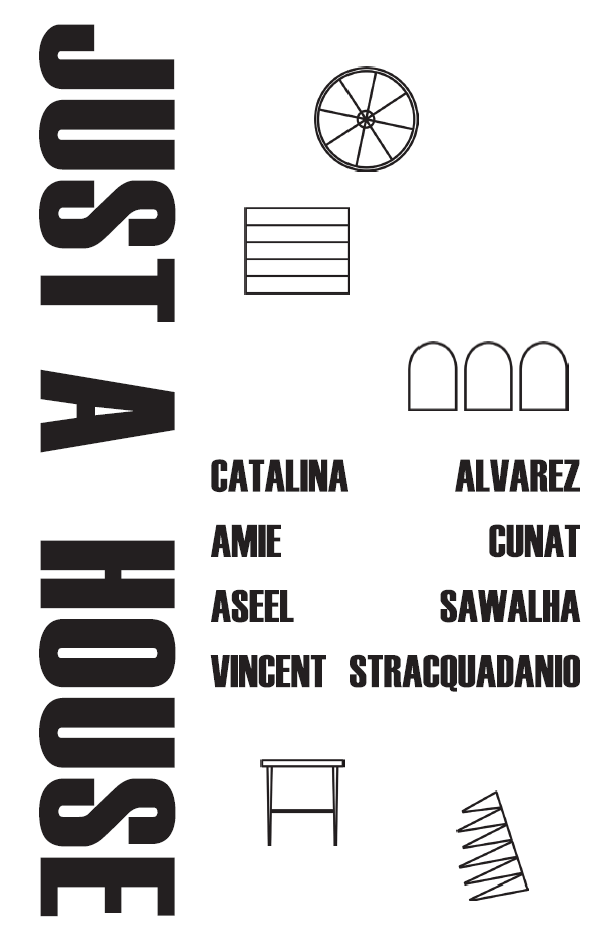
The Fordham University Galleries
Fordham University at Lincoln Center map
113 West 60th Street at Columbus Avenue
New York, NY 10023
fordhamuniversitygalleries
Fordham University and the Visual Arts Department is pleased to present Just a House, a group exhibition featuring the work of four faculty members.
How do we form feelings of beloning? Are there boundaries that describe the contour of these notions? What histories are they made from? Just a House explores ideas of displacement, familiarity, comfort, and connection through sculptural installation. Each artist uses a domestic material or motif, along with an element of suspension from the gallery’s ceiling to prompt conversation about the complicated, sometimes precarious nature of belonging.
Within Catalina Alvarez’s intimate installation, a grouping of two birch stools (by Peter Blasser), a wooden table (by Daniel Fishkin), a rocking chair, and animal skins invite a visitor to watch two chapters from her anthology film, Sound Spring (Seq. #5 & #7), projected onto a centralized plinth. Unfolding in a series of eight vignettes, Sound Spring explores the history of Yellow Springs, Ohio over hundreds of years, as narrated by its residents in comical scenes: one interviewee rollerblades and reads the village’s water meters, another stands on his head in a breakdancing freeze. The villagers describe American history—their ancestors’ settlements after slavery, a friendship with Coretta Scott King, and Ohio’s Trail of Tears— among other more personal details of village life. By interacting with their own previously recorded media, villagers uncover layers of time and storytelling.
In Days I’ve Spent, Times I’ve Tried, Vincent Stracquadanio paints sequential rows of Coliseum-like archways on a bed sheet to describe a liminal space between structured architecture and soft installation; between positive and negative space; between conscious and dream worlds. With imagery that draws from Sicilian folkloric traditions, Etruscan frescoes, and Giallo horror films, Stracquadanio frequently uses patterns, gestural abstraction, or archetypical forms to flatten or expand space. The artist generates a purposeful lack of solidity and definition –as if ghostly forms are departing and floating through a dreamlike miasma—offering expressions of grief and longing.
Central points of tension acknowledge and defy the gravity of Aseel Sawalha’s objects. Lantern contains a multitude of hand-folded, paper shapes, which are connected by a system of crocheted netting that cascades from the gallery’s ceiling. The organic entanglement of the vermillion thread contradicts the sharpness of the geometric elements it binds. Passages and Spooler are made of reformations of discarded Fordham books and other found objects (Christmas tree stand, discarded mail tubes).The artist’s work is informed by ethnographic fieldwork research with Bedouin tribes, post-war Beirut, New York City women artists and the art scene in Jordan and Palestine. Meticulously constructed, the sculptures are hybrid restructurings of found books and print matter modified by hand rolling and quilling, weaving, and paint, which mesh forms from modern and post-modern visual arts with techniques from traditional Arabic and Palestinian handicrafts.
Made from paper materials and paint, Amie Cunat’s structure –with ubiquitous siding on its façade and a hunter green interior—resembles an excerpt from a Midwestern ranch-style home. Assumptions about its locale and reference are complicated by its construction. Influenced by unnamable sentience within horror movies like the The Blob, The Thing, and Them! and false front architecture, Cunat’s object contains two Crappie gills that disrupt the logical continuity of its domestic container. Window and Gills, Tatami Tan is both alien and familiar; animal and built.
Link to the exhibition
For more information, please contact Vincent Stracquadanio
For the Visual Arts Department Blog: click here.
For the Visual Arts Department Website: click here.
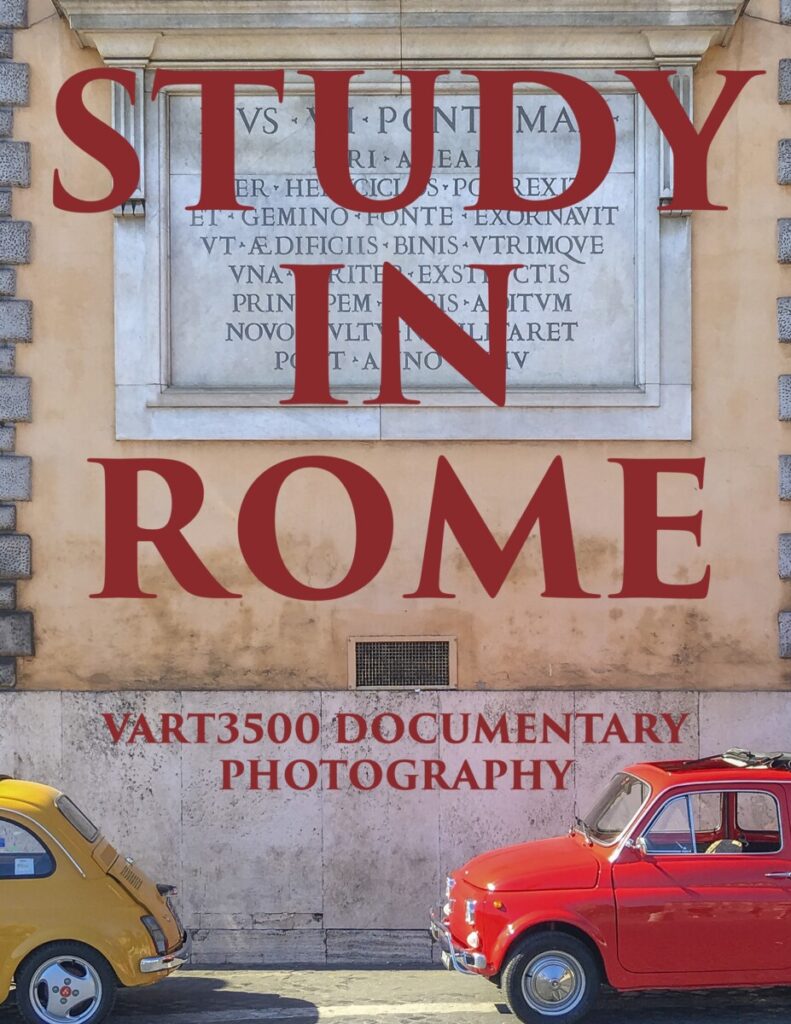
For the first time in three years, the Visual Arts Department will be running our summer course in Rome, and applications are now open for VART 3500 Documentary Photography, a Summer Session 1 course, is open to all students, so feel free to invite your non-Visual Arts Majors/Minors friends.
The course requires no prior experience with photography, and digital cameras will be provided to participants; however, it will be up to you to eat all that delicious gelato. Applications are accepted on a rolling basis, so please set up an appointment with either myself or Professor Lawton to speak more about the course if you are interested. The attached PDF shows examples of the previous student photography books, which are the culmination of the class and become a part of the university library collection, as well as some of the exhibitions of student work.
Ciao, Stephan and Joe (Stepahno & Giuseppe)
Program Fee $3,600 + 4 Credits Summer tuition
What is included:
Application Deadline:
Fordham Summer Study Abroad ScholarshipCompleted applications must be submitted by February 15. Scholarships are applied toward the summer course tuition for summer study abroad programs offered to undergraduates by the International & Study Abroad Programs Office. Award amounts will range from $500 to $1,500 and will be awarded based on financial need, academic merit, and your study abroad application essay responses.